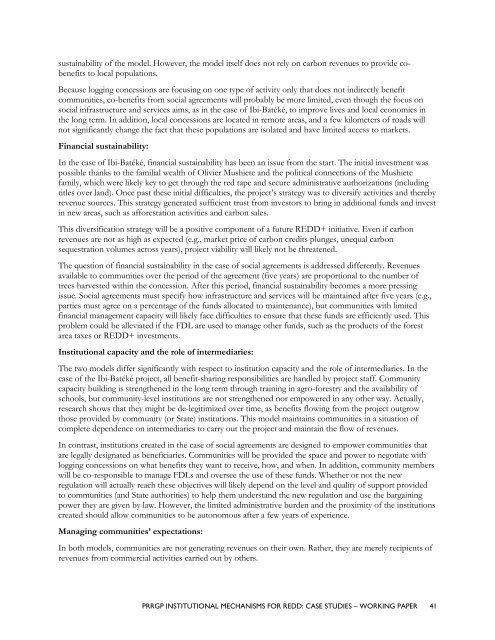Institutional Mechanisms for REDD+ - Case Studies Working Paper
Institutional Mechanisms for REDD+ - Case Studies Working Paper
Institutional Mechanisms for REDD+ - Case Studies Working Paper
You also want an ePaper? Increase the reach of your titles
YUMPU automatically turns print PDFs into web optimized ePapers that Google loves.
sustainability of the model. However, the model itself does not rely on carbon revenues to provide cobenefits<br />
to local populations.<br />
Because logging concessions are focusing on one type of activity only that does not indirectly benefit<br />
communities, co-benefits from social agreements will probably be more limited, even though the focus on<br />
social infrastructure and services aims, as in the case of Ibi-Batéké, to improve lives and local economies in<br />
the long term. In addition, local concessions are located in remote areas, and a few kilometers of roads will<br />
not significantly change the fact that these populations are isolated and have limited access to markets.<br />
Financial sustainability:<br />
In the case of Ibi-Batéké, financial sustainability has been an issue from the start. The initial investment was<br />
possible thanks to the familial wealth of Olivier Mushiete and the political connections of the Mushiete<br />
family, which were likely key to get through the red tape and secure administrative authorizations (including<br />
titles over land). Once past these initial difficulties, the project‘s strategy was to diversify activities and thereby<br />
revenue sources. This strategy generated sufficient trust from investors to bring in additional funds and invest<br />
in new areas, such as af<strong>for</strong>estation activities and carbon sales.<br />
This diversification strategy will be a positive component of a future <strong>REDD+</strong> initiative. Even if carbon<br />
revenues are not as high as expected (e.g., market price of carbon credits plunges, unequal carbon<br />
sequestration volumes across years), project viability will likely not be threatened.<br />
The question of financial sustainability in the case of social agreements is addressed differently. Revenues<br />
available to communities over the period of the agreement (five years) are proportional to the number of<br />
trees harvested within the concession. After this period, financial sustainability becomes a more pressing<br />
issue. Social agreements must specify how infrastructure and services will be maintained after five years (e.g.,<br />
parties must agree on a percentage of the funds allocated to maintenance), but communities with limited<br />
financial management capacity will likely face difficulties to ensure that these funds are efficiently used. This<br />
problem could be alleviated if the FDL are used to manage other funds, such as the products of the <strong>for</strong>est<br />
area taxes or <strong>REDD+</strong> investments.<br />
<strong>Institutional</strong> capacity and the role of intermediaries:<br />
The two models differ significantly with respect to institution capacity and the role of intermediaries. In the<br />
case of the Ibi-Batéké project, all benefit-sharing responsibilities are handled by project staff. Community<br />
capacity building is strengthened in the long term through training in agro-<strong>for</strong>estry and the availability of<br />
schools, but community-level institutions are not strengthened nor empowered in any other way. Actually,<br />
research shows that they might be de-legitimized over time, as benefits flowing from the project outgrow<br />
those provided by community (or State) institutions. This model maintains communities in a situation of<br />
complete dependence on intermediaries to carry out the project and maintain the flow of revenues.<br />
In contrast, institutions created in the case of social agreements are designed to empower communities that<br />
are legally designated as beneficiaries. Communities will be provided the space and power to negotiate with<br />
logging concessions on what benefits they want to receive, how, and when. In addition, community members<br />
will be co-responsible to manage FDLs and oversee the use of these funds. Whether or not the new<br />
regulation will actually reach these objectives will likely depend on the level and quality of support provided<br />
to communities (and State authorities) to help them understand the new regulation and use the bargaining<br />
power they are given by law. However, the limited administrative burden and the proximity of the institutions<br />
created should allow communities to be autonomous after a few years of experience.<br />
Managing communities’ expectations:<br />
In both models, communities are not generating revenues on their own. Rather, they are merely recipients of<br />
revenues from commercial activities carried out by others.<br />
PRRGP INSTITUTIONAL MECHANISMS FOR REDD: CASE STUDIES – WORKING PAPER 41

















